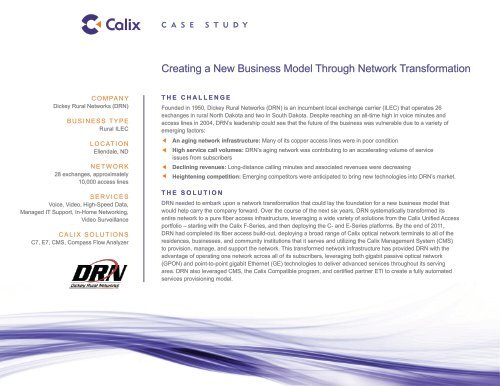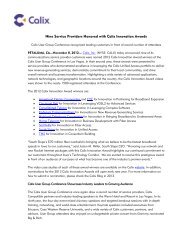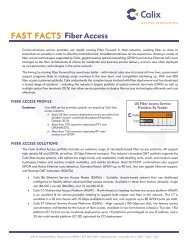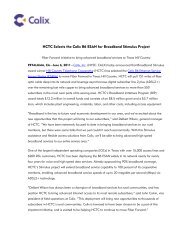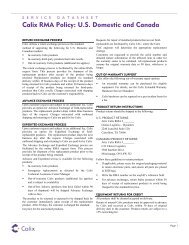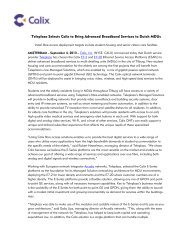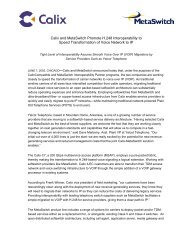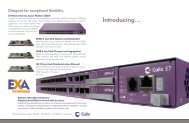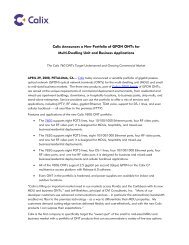v12_1738-Case Study Template - Calix
v12_1738-Case Study Template - Calix
v12_1738-Case Study Template - Calix
Create successful ePaper yourself
Turn your PDF publications into a flip-book with our unique Google optimized e-Paper software.
C A S E S T U D Y<br />
Creating a New Business Model Through Network Transformation<br />
COMPANY<br />
Dickey Rural Networks (DRN)<br />
BUSINESS TYPE<br />
Rural ILEC<br />
LOCATION<br />
Ellendale, ND<br />
NETWORK<br />
28 exchanges, approximately<br />
10,000 access lines<br />
SERVICES<br />
Voice, Video, High-Speed Data,<br />
Managed IT Support, In-Home Networking,<br />
Video Surveillance<br />
CALIX SOLUTIONS<br />
C7, E7, CMS, Compass Flow Analyzer<br />
THE CHALLENGE<br />
Founded in 1950, Dickey Rural Networks (DRN) is an incumbent local exchange carrier (ILEC) that operates 26<br />
exchanges in rural North Dakota and two in South Dakota. Despite reaching an all-time high in voice minutes and<br />
access lines in 2004, DRN’s leadership could see that the future of the business was vulnerable due to a variety of<br />
emerging factors:<br />
An aging network infrastructure: Many of its copper access lines were in poor condition<br />
High service call volumes: DRN’s aging network was contributing to an accelerating volume of service<br />
issues from subscribers<br />
Declining revenues: Long-distance calling minutes and associated revenues were decreasing<br />
Heightening competition: Emerging competitors were anticipated to bring new technologies into DRN’s market.<br />
THE SOLUTION<br />
DRN needed to embark upon a network transformation that could lay the foundation for a new business model that<br />
would help carry the company forward. Over the course of the next six years, DRN systematically transformed its<br />
entire network to a pure fiber access infrastructure, leveraging a wide variety of solutions from the <strong>Calix</strong> Unified Access<br />
portfolio – starting with the <strong>Calix</strong> F-Series, and then deploying the C- and E-Series platforms. By the end of 2011,<br />
DRN had completed its fiber access build-out, deploying a broad range of <strong>Calix</strong> optical network terminals to all of the<br />
residences, businesses, and community institutions that it serves and utilizing the <strong>Calix</strong> Management System (CMS)<br />
to provision, manage, and support the network. This transformed network infrastructure has provided DRN with the<br />
advantage of operating one network across all of its subscribers, leveraging both gigabit passive optical network<br />
(GPON) and point-to-point gigabit Ethernet (GE) technologies to deliver advanced services throughout its serving<br />
area. DRN also leveraged CMS, the <strong>Calix</strong> Compatible program, and certified partner ETI to create a fully automated<br />
services provisioning model.
“Fiber-to-the-home can do a great deal for<br />
residents and businesses in rural America.<br />
The speed and reliability of fiber has allowed<br />
DRN to outpace the competition with<br />
bandwidth-rich services, while reducing<br />
our operating expenses and re-energizing<br />
our workforce. ”<br />
– Jeff T. Wilson, General Manager, DRN<br />
THE RESULTS<br />
DRN’s network and business transformation is a textbook example of the extraordinary results that communications<br />
service providers, <strong>Calix</strong>, and <strong>Calix</strong> partners can achieve by working together.<br />
A better service experience: New services like high-speed data and video have driven broadband subscriber<br />
adoption. High-speed data take rates have grown from six percent in 2004 to over 75 percent today, with packages<br />
that range from 5 megabits per second (Mbps) to 100 Mbps to the home or business. In addition, DRN plans to offer<br />
a 500 Mbps service in the future.<br />
Dramatically lower service call volumes: As new fiber optic cable replaced DRN’s maintenance-heavy aging copper<br />
plant, the company has seen after-hours help calls reduced by an order of magnitude – from 3000 per month to less<br />
than 300 per month.<br />
New provisioning efficiencies: Working with <strong>Calix</strong> Compatible partners like ETI (with its Triad provisioning system),<br />
DRN has completely automated its service provisioning model. In addition, the team of five employees that historically<br />
had been charged with manually provisioning each service to subscribers has been disbanded and it members<br />
retrained to focus on new service areas.<br />
Re-deployment of resources: Because of the much lower maintenance requirements and higher efficiencies of a fiber<br />
access infrastructure, DRN has reduced its overall number of employees by over 25 percent. In addition, many field<br />
technicians and former service provisioning team members have been retrained to support new roles like technical<br />
assistance and new service research and testing.<br />
An enhanced focus on new subscriber services: For business customers, DRN has created a managed IT<br />
service team that works with schools and businesses for large-scale IT programs. For residential subscribers, the<br />
DRN residential technical support team helps subscribers install and manage the devices and systems in their homes.<br />
This includes conducting classes on general computer information, e-mail, web applications, and web cameras.<br />
The success of these programs, along with computer and smart TV giveaway promotions, has further enhanced<br />
service take rates and revenues.<br />
THE FUTURE<br />
Enabled by a <strong>Calix</strong> powered, all-fiber network, DRN has shifted its focus from maintenance of the network to rewarding<br />
its subscribers. Through network transformation, DRN has created a new, efficient internal structure with re-allocated<br />
and trained employees for accelerated introduction of new services to the market. Operational spending has been reduced<br />
dramatically, with field support resources at 50 percent of their 2004 levels. According to the 2011 Telergee Alliance<br />
Benchmarking <strong>Study</strong> of the rural telecom industry – which surveyed operational metrics of over 200 companies – DRN’s<br />
operating margins of over 27 percent are nearly 2.5 times better than the average of their similar-size peers and more<br />
than five times better than the industry as a whole. In addition, DRN has introduced compelling new services and revenue<br />
opportunities, from IPTV and high-speed data services to new broadband-enabled service opportunities such as managed<br />
IT support, video surveillance, and in-home networking. Perhaps most importantly, DRN has been able to strengthen its<br />
community ties through bringing the promise of broadband to the communities it serves, furthering the reach of rural<br />
broadband as part of a 9000-square-mile area all connected with fiber, and educating subscribers on the opportunities<br />
broadband brings.<br />
1035 North McDowell Petaluma, CA 94954 T 1 877 462 2549 F 1 707 283 3100 www.calix.com


